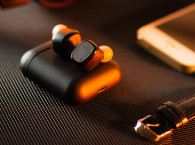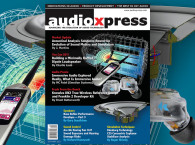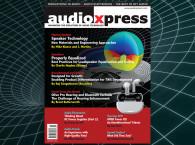
A decade ago, designing earphones was relatively easy. You had a driver — usually just one — and an enclosure, and that’s it. For the small cadre of audio engineers who understood the acoustics of pea-sized drivers mounted in a housing the size of a small olive, the task was straightforward. But these days, all but the cheapest earphones are true wireless designs. At the very least, they have microphones for voice pickup, but even some under $50 models now incorporate active noise cancelling (ANC) for playback.
Many of these add multiple drivers in the search for better sound, and multiple microphones to improve voice pickup. Some access voice command systems such as Amazon Alexa and Apple Siri. Some even add heart-rate sensors, bone-conduction drivers and sensors, and hearing enhancement features.
Knowles — known for decades primarily as a manufacturer of balanced-armature drivers and subminiature microphones — is striving to make the development of advanced true wireless models easier by offering two options to product designers.
The KN2 is a finished reference design, a hybrid true wireless model with a balanced armature tweeter and a dynamic midrange/woofer and equipped with noise canceling. Companies that prefer the simplicity of adopting an existing design rather than developing one themselves can apply their brand to the KN2 and have it manufactured by the same vendor that produces the KN2 for Knowles.
The Franklin 2 is a full-on development kit that lets product designers experiment with hybrid earphone designs using Knowles’ balanced armatures, augmented with an Ole Wolff dynamic driver for the bass. (The greater bass capability of the dynamic driver facilitates more powerful noise cancelling as well as deeper, stronger bass output.) Each earphone also incorporates five microphones and a bone-conduction sensor, all of which can be accessed through the Franklin 2’s breakout board. A multi-conductor ribbon cable connects each earphone to the board (Photo 1).

For product development teams, the Franklin 2 provides a ready-to-go platform for evaluating Bluetooth chipsets, experimenting with different noise-cancelling algorithms for playback and voice pickup, and gaining experience with balanced armatures, multiple-microphone arrays, and bone conduction sensors.
What’s the Angle?
Knowles created these devices for two reasons: first, to promote the use of its microphones and balanced armatures; and second, as a demo platform for the Knowles Preferred Listening Response Curve.
The Preferred Listening Response Curve arose as an extension to the famous Harman curve research. The Harman curve used extensive blind listening tests and measurements to determine what frequency response listeners prefer in headphones and earphones. It’s been widely accepted as a baseline; a discussion of how a product’s frequency response deviates from the Harman curve is now an expected feature of serious headphone and earphone reviews.
However, the Harman curve research was conducted using a so-called “711” ear simulator, which conforms to International Electrotechnical Commission (IEC) 60318-4, which was updated in 2010 but based on the IEC 60711 standard established in 1981. The 711 coupler’s response is defined only up to 10kHz—fine for gauging voice reproduction, but inadequate for the full 20kHz range of high-fidelity music reproduction.
In 2018, so-called “high-resolution” ear simulators were introduced, with consistent and defined response up to 20kHz or even higher. (We tested the GRAS RA0402 high-resolution ear simulator in the May 2018 issue of audioXpress.)
Observing this development, Knowles decided to expand on the Harman curve research, conducting a new series of listening tests, followed by measurements with a high-resolution ear simulator, to see if consistent preferences for response above 10kHz could be determined, and “tacked on” as an extension to the right side of the Harman curve, as a guide to preferred high-frequency reproduction.
The specifics appear in a paper delivered at the October 2022 Audio Engineering Society (AES) Convention by Knowles R&D fellow Thomas Miller and electroacoustic engineer Cristina Downey, titled “A Wideband Target Response Curve for Insert Earphones.” The paper states that listeners aged 22 to 35 preferred a response where the upper octave of treble was roughly equal in energy to the Harman-curve response at 1kHz. Listeners in older age groups preferred boosted high treble, with response above 10kHz roughly equal in magnitude to the Harman curve’s 3kHz response peak.
The paper recommends a boost at 16kHz, relative to the Harman curve response at 1kHz, with a Q of 4, the boost increasing depending on the user’s age — roughly 3dB for every 10 years over age 30. That’s a big boost. For my age group (56 to 65), the recommended boost ranges from +12dB to +27dB. For dynamic drivers, which are relatively insensitive in the top octave of treble, this is a tall order, especially considering the very limited amplifier power in true wireless earphones; it appears achieving the Knowles curve will be difficult unless balanced armatures or some other drivers with extended high-frequency response are used.
The KN2 is tuned to the Knowles curve. To my knowledge, it’s the only such product currently—well, not available exactly, but accessible to audio industry pros. (Knowles says that a few currently available true wireless earphones, including the Soundcore Liberty 3 Pro and the Edifier NeoBuds Pro, are tuned similar to the Knowles curve but with mild deviation in pursuit of their own sound signature.) However, the Franklin 2, I came to find out, doesn’t seem to be provided in any particular state of tune.
Testing the KN2
The KN2 is not what I’d call a “reference design” — which I’d define as a component that works well enough to demonstrate a technology, but isn’t, at least on its own, something ready to ship out to consumers. The KN2, despite wearing the Knowles brand, is a finished product. You can slap your own brand on the sides and the case, add your own packaging and a manual, and ship it right out to retailers.
I’d call the KN2 “medium-sophisticated” in comparison with other true wireless models. It’s not as “smart” as the most advanced models from Apple and Samsung, but it does include noise cancelling with an Ambient (transparency) mode for hear-through operation, plus a body-temperature sensor. An app accesses these features as well as a nine-band EQ — and yes, the EQ does include a 16kHz slider so users can tailor the “Knowles curve boost” to their liking. It also accesses several tones and music clips intended as environmental sound for relaxing, studying, and more. A charging case is included; it offers wireless Qi charging as well as USB-C charging. In addition to the standard SBC Bluetooth codec, the KN2 offers AAC as well as aptX Adaptive. Oval-shaped silicone eartips in three sizes are included (Photo 2).

When Knowles first published the Preferred Listening Response Curve, I experimented with software EQ to simulate the curve, and generally liked what I heard. It basically enhanced the extreme highs while leaving everything else alone, giving the music a little more detail and spaciousness. However, it’s important to note that I’m a 61-year-old male, and therefore do not have intact hearing. I can’t hear discrete tones above about 12kHz. I don’t know if a younger listener with better hearing would react as favorably to the extreme 16kHz boost as I did.
When I first listened to the KN2, I thought it sounded much like my Knowles curve experiments did — basically, the neutral (in my view, at least) sound of Harman curve, with an appealing amount of extra highs added. However, after a few days of using the KN2 for my gym visits and daily dog walks, I stopped noticing the effect because I got used to it.
The noise cancelling seemed to work pretty well. It substantially reduced airliner cabin noise on the two flights I took with the KN2, and it also brought down the noise level in my gym (which tends to play hip-hop and nu-metal at levels averaging around 90dBC) down to where the music didn’t significantly distract from the podcasts I listened to while riding the exercise bike.
Measuring the KN2
I ran a few measurements of the KN2, using a GRAS RA0402 high-resolution coupler and 43AG ear/cheek simulator, an Audiomatica Clio 12 analyzer, and an M-Audio Mobile Pre USB interface with True Audio’s TrueRTA spectrum-analyzer app (Photo 3). I used a MEE Audio USB Bluetooth transmitter to get audio signals into the earphones.

A frequency response plot shows something similar to a Harman curve, but with more energy above 10kHz (Figure 1). You may notice that there’s also less bass. Knowles says this result is not accurate, and I would guess they are correct. My CLIO analyzer sometimes produces unusual results when forced to deal with Bluetooth’s latency, and I never noticed any lack of bass in my listening. I will note that I achieved similar results with the left and right earphones, with a second KN2 sample, with all of the different tip sizes, and with numerous adjustments of the Clio’s settings. I also tried a Reiyin USB Bluetooth transmitter, but the results with that one were inconsistent.

The KN2 appears to be tuned to the variant of Knowles curve designed for younger listeners. Remember that for that group, the response above 10kHz is supposed to be roughly equivalent to the response of the earphones at 1kHz; in this case it’s close, but down by about -1dB to -3dB from what’s specified in Knowles’ paper.
Of course, adjusting the 16kHz slider in the app’s EQ could increase that. As the earphones are delivered, the 16kHz response is +6dB to +15dB higher compared with two other models I included in the chart (Figure 2) — the KEF Mu3 (which comes closest to Harman curve of any true wireless earphones I’ve measured) and the passive AKG N5005 (said to be the earphones that most closely track the Harman curve). So, the KN2 seems to hold tightly to Knowles’s concept.

The hybrid design should, in theory, improve the noise cancelling, because balanced armatures generally don’t have enough deep bass response to generate sufficient SPL to cancel loud low-frequency noise. In practice, it does indeed work well.
I compared the KN2’s noise cancelling with two other true wireless models known for very good noise cancelling: the Bose QuietComfort Earbuds 2 and the Soundcore Liberty 3 Pro, a hybrid design (Figure 3). The KN2’s performance on this test is excellent at the low frequencies where airliner cabin noise, HVAC system noise, and more resides. Above that range, the Bose model clearly outperforms the others, likely because of superior passive isolation; active noise cancelling in headphones and earphones is generally limited to frequencies below 1kHz to avoid feedback.

I also measured the effects of the KN2’s different noise cancelling modes (Figure 4). These work more or less as expected, although the lower ANC setting doesn’t reduce the noise cancelling much compared with the maximum ANC setting.

Last, I measured the total harmonic distortion vs. frequency for the KN2 at a level of 90dBA, measured with pink noise. The results (Figure 5) are typical for true wireless earphones. Distortion is noticeable, but too low to be troublesome. Normally, I like to add a measurement at 100dBA, which I often find is near the “break point” for headphones and earphones to distort badly, but as with many true wireless designs I’ve tested, the KN2 wouldn’t hit that volume even with the CLIO’s output set to maximum. However, I never noticed a lack of sufficient volume when listening to them.

Testing the Franklin 2
Although I didn’t have a digital development board that would allow me to use the Franklin 2 as a product development engineer would, I did get a chance to play around with it a little and run some measurements (Photo 4).

The Franklin 2’s connections and features are clearly laid out on the board and in the accompanying manual, so it wasn’t difficult for me to access the drivers for some measurements. Jumpers let you access the drivers together or individually. The balanced armature uses a 1μF series capacitor to provide 6dB/octave of protection against damage from excessive bass, but this can be bypassed.
In addition to an Ole Wolff dynamic driver and a Knowles balanced armature, each of the earphones also incorporates five Knowles Titan microphones: four on the outer part of the earpiece, and a fifth on the interior to provide a feedback signal for noise cancelling. There’s also a Knowles V2S (Voice Vibration Sensor) bone-conduction sensor. This can be used to enhance the efficacy of the microphones in voice pickup and improve noise cancelling on the mics; the bone-conduction sensor provides a “pure” voice signal, unaffected by environmental noise or echoes of the user’s voice from surrounding surfaces. (Without having a digital development board on hand, I couldn’t evaluate the microphones or bone-conduction sensor in any meaningful way.)
I do have one ergonomic complaint about the Franklin 2 — while it’s easy to run measurements on the earphones, it’s very difficult to listen to them because the ribbon cables connecting them to the board are so short. I did try, but the board got tangled in my beard and I was never able to get a tight seal of the earphones in my ear canals, which is required for listening tests.
What I did learn in my measurements of the Franklin 2 is that while the Knowles curve’s >10kHz boost is readily apparent in the frequency response chart (Figure 6), the earphones don’t appear to be as meticulously tuned as the KN2. The response has strong, high-Q peaks centered at 2kHz and 4kHz, and milder peaks centered at roughly 10kHz and 16kHz. Compared with most of the earphones I’ve measured, this response looks unusual. (Unfortunately, not being able to get a good seal because of the short cables, I wasn’t able to give the Franklin 2 a fair listen.) However, this doesn’t really matter, as the Franklin 2 would always be used with a digital development board that would offer enough EQ filters to achieve any tuning you might want.

I was also able to measure the drivers individually (Figure 7). I kept the series capacitor in the circuit to make sure I didn’t damage the balanced armature. The dynamic driver dominates the response up to about 5kHz, and the balanced armature has no significant contribution below about 4kHz.

Bottom Line
I’ve reviewed or measured at least 50 sets of true wireless earphones in the last few years, and in terms of sound quality and noise cancelling, I’d consider the KN2 competitive with many of the best out there today. Of course, I can’t compare it to “similarly priced models,” because the KN2 doesn’t have a retail price. I’d say it most closely compares with KEF’s excellent Mu3 earphones; the sound quality and industrial designs are similar, but the KN2’s noise cancelling is considerably better.
While I’m not the target market for the Franklin 2, the fact that I was able to navigate its connections and access and evaluate its drivers without using a digital development board — in fact, with nothing but a couple of quickly soldered adapter cables — suggests it can serve as a practical, easy-to-use tool for evaluating true wireless earphone technologies. aX
This article was originally published in audioXpress, September 2023






